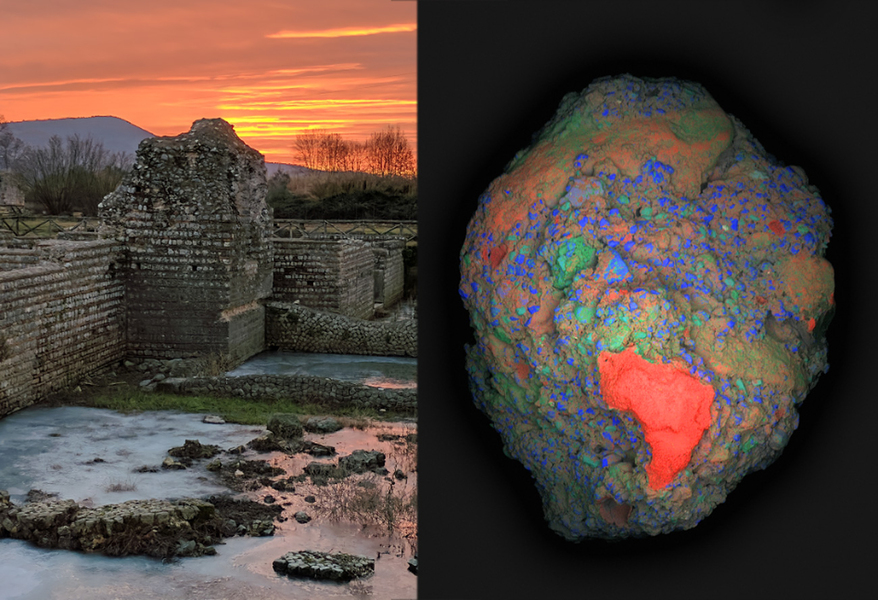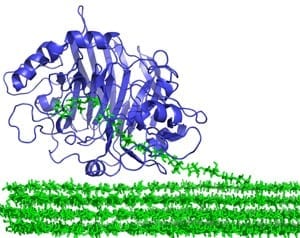
Berkeley Lab scientists and their colleagues have discovered the properties that made ancient Roman concrete sustainable and durable
The chemical secrets of a concrete Roman breakwater that has spent the last 2,000 years submerged in the Mediterranean Sea have been uncovered by an international team of researchers led by Paulo Monteiro of the U.S. Department of Energy’s Lawrence Berkeley National Laboratory (Berkeley Lab), a professor of civil and environmental engineering at the University of California, Berkeley.
Analysis of samples provided by team member Marie Jackson pinpointed why the best Roman concrete was superior to most modern concrete in durability, why its manufacture was less environmentally damaging – and how these improvements could be adopted in the modern world.
“It’s not that modern concrete isn’t good – it’s so good we use 19 billion tons of it a year,” says Monteiro. “The problem is that manufacturing Portland cement accounts for seven percent of the carbon dioxide that industry puts into the air.”
Portland cement is the source of the “glue” that holds most modern concrete together. But making it releases carbon from burning fuel, needed to heat a mix of limestone and clays to 1,450 degrees Celsius (2,642 degrees Fahrenheit) – and from the heated limestone (calcium carbonate) itself. Monteiro’s team found that the Romans, by contrast, used much less lime and made it from limestone baked at 900? C (1,652? F) or lower, requiring far less fuel than Portland cement.
Cutting greenhouse gas emissions is one powerful incentive for finding a better way to provide the concrete the world needs; another is the need for stronger, longer-lasting buildings, bridges, and other structures.
“In the middle 20th century, concrete structures were designed to last 50 years, and a lot of them are on borrowed time,” Monteiro says. “Now we design buildings to last 100 to 120 years.” Yet Roman harbor installations have survived 2,000 years of chemical attack and wave action underwater.
How the Romans did it
The Romans made concrete by mixing lime and volcanic rock. For underwater structures, lime and volcanic ash were mixed to form mortar, and this mortar and volcanic tuff were packed into wooden forms. The seawater instantly triggered a hot chemical reaction. The lime was hydrated – incorporating water molecules into its structure – and reacted with the ash to cement the whole mixture together.
Descriptions of volcanic ash have survived from ancient times. First Vitruvius, an engineer for the Emperor Augustus, and later Pliny the Elder recorded that the best maritime concrete was made with ash from volcanic regions of the Gulf of Naples (Pliny died in the eruption of Mt. Vesuvius that buried Pompeii), especially from sites near today’s seaside town of Pozzuoli. Ash with similar mineral characteristics, called pozzolan, is found in many parts of the world.
Using beamlines 5.3.2.1, 5.3.2.2, 12.2.2 and 12.3.2 at Berkeley Lab’s Advanced Light Source (ALS), along with other experimental facilities at UC Berkeley, the King Abdullah University of Science and Technology in Saudi Arabia, and the BESSY synchrotron in Germany, Monteiro and his colleagues investigated maritime concrete from Pozzuoli Bay. They found that Roman concrete differs from the modern kind in several essential ways.
One is the kind of glue that binds the concrete’s components together. In concrete made with Portland cement this is a compound of calcium, silicates, and hydrates (C-S-H). Roman concrete produces a significantly different compound, with added aluminum and less silicon. The resulting calcium-aluminum-silicate-hydrate (C-A-S-H) is an exceptionally stable binder.
At ALS beamlines 5.3.2.1 and 5.3.2.2, x-ray spectroscopy showed that the specific way the aluminum substitutes for silicon in the C-A-S-H may be the key to the cohesion and stability of the seawater concrete.
Another striking contribution of the Monteiro team concerns the hydration products in concrete. In theory, C-S-H in concrete made with Portland cement resembles a combination of naturally occurring layered minerals, called tobermorite and jennite. Unfortunately these ideal crystalline structures are nowhere to be found in conventional modern concrete.
The Latest Bing News on:
Roman concrete
- The Armenian Genocide and architecture: How they intersecton April 28, 2024 at 4:30 am
How does this all connect How does a suburban Texas church tie to these musings about the unifying power of architecture Or to the first modern genocide ...
- From Mud Bricks to Smart Concrete: A Brief History of Building Materials Technologyon April 26, 2024 at 5:34 am
From mixing lime with water to self-sensing concrete, building materials technology has come a long way—and so have building standards.
- Sumy Oblast fortifies amid looming threat of Kharkiv attackon April 25, 2024 at 2:03 pm
The military commander says he plans to plant more landmines and build additional fortifications, turning the strip into an impregnable fortress where no Russian troops or hardware can enter without ...
- Deciphered Herculaneum papyrus reveals precise burial place of Platoon April 25, 2024 at 10:33 am
Most notably, the historical account of Plato being sold into slavery in his later years after running afoul of the tyrannical Dionysius is usually pegged to around 387 BCE. According to the newly ...
- Pre-Roman Necropolis Discovered in Valle Telesinaon April 25, 2024 at 9:32 am
The Archaeology, Fine Arts and Landscape Superintendence (Sabap) for the provinces of Caserta and Benevento presented to the Municipality of Amorosi, during a press conference, the ...
- The extraordinary and ancient secret places hidden under Turkeyon April 25, 2024 at 1:37 am
Turkey is rich with ancient wonders, and many of these are hidden below the surface, often only being discovered after centuries of being buried and forgotten.
- Tracing the Long, Winding Path of an Ancient Roman Aqueducton April 24, 2024 at 1:59 am
The Aqua Marcia was the longest of the city’s aqueducts, running nearly 60 miles from its source in the countryside to the heart of ancient Rome. The author followed its course, above and below ground ...
- Logistics Campus at former Allstate headquarters off to slow start, with plans for lab-grown meat plant on holdon April 23, 2024 at 3:00 am
Post-pandemic demand for industrial space has slowed just as developments like the logistics center at the former Allstate site are set to come online.
- Ancient Roman Wine Might Have Tasted Surprisingly Good, New Study Suggestson April 22, 2024 at 3:59 am
It is alleged that Roman winemakers had to mask their products’ flaws by adding spices, herbs, and other ingredients to the freshly pressed grape juice.
- Archaeologists Discover Skeletal Remains, Remarkably Preserved Glassware at Ancient Roman Settlementon April 21, 2024 at 1:00 pm
According to Archaeology Magazine (via INRAP) they date back to somewhere between the 2nd and 1st centuries B.C. and 2 A.D. and were made near the Via Domitia, once a major Roman trading route. A ...
The Latest Google Headlines on:
Roman concrete
[google_news title=”” keyword=”Roman concrete” num_posts=”10″ blurb_length=”0″ show_thumb=”left”]
The Latest Bing News on:
Durable concrete
- What To Consider Before Making The Swap To Concrete Flooringon April 27, 2024 at 12:14 pm
Concrete is an almost perfect option to serve as the flooring of any room in the home. It's one of the most durable, maintainable floors out there, capable of withstanding the heaviest of furniture, a ...
- Rising Construction Activities Propel Global Concrete Admixture Demand, Anticipated to Reach US$ 27.4 Billion by 2032on April 26, 2024 at 7:59 am
The global concrete admixture market is expected to reach a value of US$ 15.1 Billion in 2022. With a steady CAGR of 6.1%, the market will reach US$ 27.4 Billion by 2032. A notable rise in the use of ...
- From Mud Bricks to Smart Concrete: A Brief History of Building Materials Technologyon April 26, 2024 at 5:34 am
From mixing lime with water to self-sensing concrete, building materials technology has come a long way—and so have building standards.
- American Concrete Institute Elects 2024-2025 President and Boardon April 25, 2024 at 10:05 pm
The American Concrete Institute (ACI) has announced its 2024-2025 president, vice president, and four board members.
- Making old buildings new again: the case for adaptive reuseon April 25, 2024 at 12:22 am
Extending a structure’s operational life helps maximize the built environment’s embodied energy and sustain the spirit older buildings bring to their communities.
- Theatre closes for investigation over Raac concernson April 24, 2024 at 4:18 am
A Surrey theatre has closed for an investigation into the safety of its concrete structure. Camberley Theatre was built in 1966 when reinforced autoclaved aerated concrete (Raac) was used, a ...
- Iphone 15 Durability Teston April 22, 2024 at 10:11 pm
Find Iphone 15 Durability Test Latest News, Videos & Pictures on Iphone 15 Durability Test and see latest updates, news, information from NDTV.COM. Explore more on Iphone 15 Durability Test.
- Exploring low carbon concrete solutions for Scottish offshore wind farmson April 22, 2024 at 3:14 am
Global BW Ideol and Holcim have signed a MoU for a feasibility study on supplying beneficial low-carbon concrete for the floating offshore wind industry, with particular reference to Scotland.
- Multiquip’s Zero Emissions Mix-N-Go Concrete Mixer Features Rechargable Battery Driveon April 16, 2024 at 1:23 pm
Developed to meet the demands of construction sites while adhering to eco-friendly standards, this mixer delivers in terms of efficiency, convenience, and environmental ...
- Kilsaran launches two electric concrete truckson April 16, 2024 at 2:39 am
Kilsaran, a major player in Ireland's construction industry, has announced the launch of two new electric concrete trucks.
The Latest Google Headlines on:
Durable concrete
[google_news title=”” keyword=”durable concrete” num_posts=”10″ blurb_length=”0″ show_thumb=”left”]










